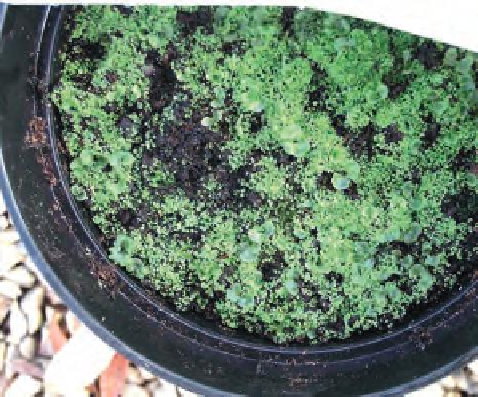Agriculture Reference
In-Depth Information
X
Wind
: the seeds of poppy capsules (
Papaver
) are
shaken from small pores in the fruit as the plant
sways like a church censer. Other fruits have
tiny feathery parachutes attached as in
Epilobium
(willow herb),
Clematis
and many members of
the daisy family including
Senecio
(groundsel),
Taraxacum
(dandelion) and
Cirsium
(thistles). Many
woody species such as
Tilia
(lime),
Fraxinus
(ash)
,
Acer
(sycamore and maples) produce winged fruit.
X
Animals
: mammals and birds can distribute
fruits either externally or internally. Hooked fruits,
e.g.
Galium aparine
(goosegrass) and
Arctium
(burdocks), become attached to animal's fur. The
sticky succulent fruits of
Viscum album
(mistletoe)
attach to birds' beaks and are rubbed off onto
trees where they germinate. Squirrels may bury
fruits such as nuts, e.g.
Quercus robur
(oak),
Fagus sylvatica
(beech),
Castanea sativa
(sweet
chestnut), in the ground far from where they were
collected (scatter hoarding). Succulent fruits, e.g.
Solanum lycopersicon
(tomato),
Rubus fruticosus
(blackberry),
Prunus spinosa
(sloe)
, Viburnum
and
Sambucus nigra
(elderberry), or those that are fi lled
with protein, e.g.
Rumex
(dock), are eaten by birds
and other animals, the seeds passing through their
gut before being deposited elsewhere (
frugirory
).
X
Water
: many aquatic plants such as
Nymphaea
(waterlilies) or those growing close to rivers and
seashores use water to disperse their fruits. The
fruits of coconut palms can travel thousands of
kilometres in ocean currents. The introduced weed
Reproduction in non-seed producing plants
In higher plants, seeds are the means by which
they colonize new areas and reduce competition
from the parent plant and other seedlings.
However, simpler multicellular green plants such
as mosses and ferns do not produce seeds, so
other means of dispersal are needed. In these
plants, during their life cycles, two stages of
quite distinct types of growth occur. In
ferns
,
for example, the typical fern plant which we see
growing is a vegetative phase of the life cycle.
Spores are released from the underside of the
fronds and are dispersed by the wind (Figure
8.15). With suitable damp conditions, they
germinate to produce a second sexual stage.
Each spore grows into a tiny leafy structure in
which male and female organs develop and
release sex cells which fuse. The cell resulting
from this fertilization gives rise to a new fern
plant and the small leafy structure withers
away (Figure 8.16). Ferns can be produced in
cultivation by spores if provided with damp
sterile conditions to allow the tiny spores to
germinate without competition (see p. 133).
8
Figure 8.15
Sori, brown spore-producing structures
on the underside of fern fronds: left:
Asplenium
scolopendrium
'Cristata' (crested hart's tongue fern);
right:
Dryopteris erythrosora
Figure 8.16
Germinating fern spores and plantlets





